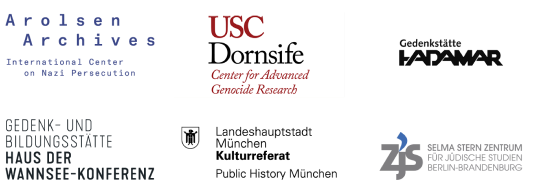Annotations
Dortmund
07/29/1942
Forced march of the people to be deported from the assembly camp to the Dortmund-Süd train station at the corner of Viehmarktstraße and Steinstraße. The people standing under the tree are presumably employees of the Dortmund Gestapo. The field of vision is restricted by window grilles.
Annotations
Keywords
3
Historical context
Deportation von Dortmund nach Theresienstadt am 29.07.1942
On July 29, 1942, the Dortmund Gestapo deported 808 mostly elderly Jews from Westphalia to the Theresienstadt ghetto. The "Börse" restaurant and stables of the nearby cattle market north of Dortmund's main train station were used as assembly points. The people to be deported had to present themselves there two days before already. On the morning of July 29, a Wednesday, they marched about two kilometers across the city center to the Dortmund-Süd train station, the departure point of the deportation train. Here, 156 Jewish deportees from Luxembourg, who had arrived in Dortmund earlier by train, were forced to board the deportation train as well. The Da 72 train from Dortmund reached a station near Theresienstadt on July 30 after about 20 hours of travel. The ghetto was extremely overcrowded in the summer of 1942. Most of the deported people either died in Theresienstadt or were moved on to the Treblinka and Auschwitz-Birkenau extermination camps and murdered there.
About the image series
Only a reproduction of one photograph of this deportation has survived. It is very probable that the picture was taken secretly from the garages of Dortmund's Steinwache police prison. It shows Jewish people marching to the Dortmund-Süd train station shortly after leaving the assembly camp at the "Börse" restaurant on the corner of Viehmarktstraße and Steinstraße. None of the people on the photo have yet been identified by name.
Photographer
Unknown, police officer responsible for air-raid protection
The photographer is not known by name. According to Ludwig Beck, a former police officer responsible for air-raid protection, the photographer was a colleague. Both were stationed on the site of Dortmund's Steinwache police prison. The picture was probably taken secretly from a window in the garage wing as the persons to be deported passed the premises at Steinstraße.
Provenance
After 1945, Ludwig Beck, a former police officer responsible for air-raid protection, had the original print of the photo in his possession. Beck was considered a "half-Jew" during the Nazi era. During World War II, he was stationed at Steinwache for some time. According to Beck, the photographer was a colleague also working there. When he was interviewed by a city archive employee and a former police archivist, Alexander Primavesi, in the 1980s, Beck showed them the photo, which was part of a photo album back then. The album did not contain any other deportation photos, though. A reproduction was made, which is now preserved in Stadtarchiv Dortmund. The original was returned to Beck; it is now considered lost.
Call number at source archive
ohne Signatur
Title at source archive
ohne Titel
Acknowledgements
The archival description of the photo is largely based on earlier research by Stadtarchiv Dortmund and in particular by historian Rolf Fischer, who has broadly researched deportations from Dortmund (see Rolf Fischer: Verfolgung und Vernichtung. Die Dortmunder Opfer der Shoah, Essen 2015).
Text and research by Henning Borggräfe.
Kooperationsverbund #LastSeen. Bilder der NS-Deportationen Dr. Alina Bothe Projektleiterin
c/o Selma Stern Zentrum für Jüdische Studien Berlin-Brandenburg
Freie Universität Berlin
Habelschwerdter Allee 34A
14195 Berlin
lastseen@zedat.fu-berlin.de
Ein Kooperationsprojekt von

Gefördert durch

Datenschutz | Impressum